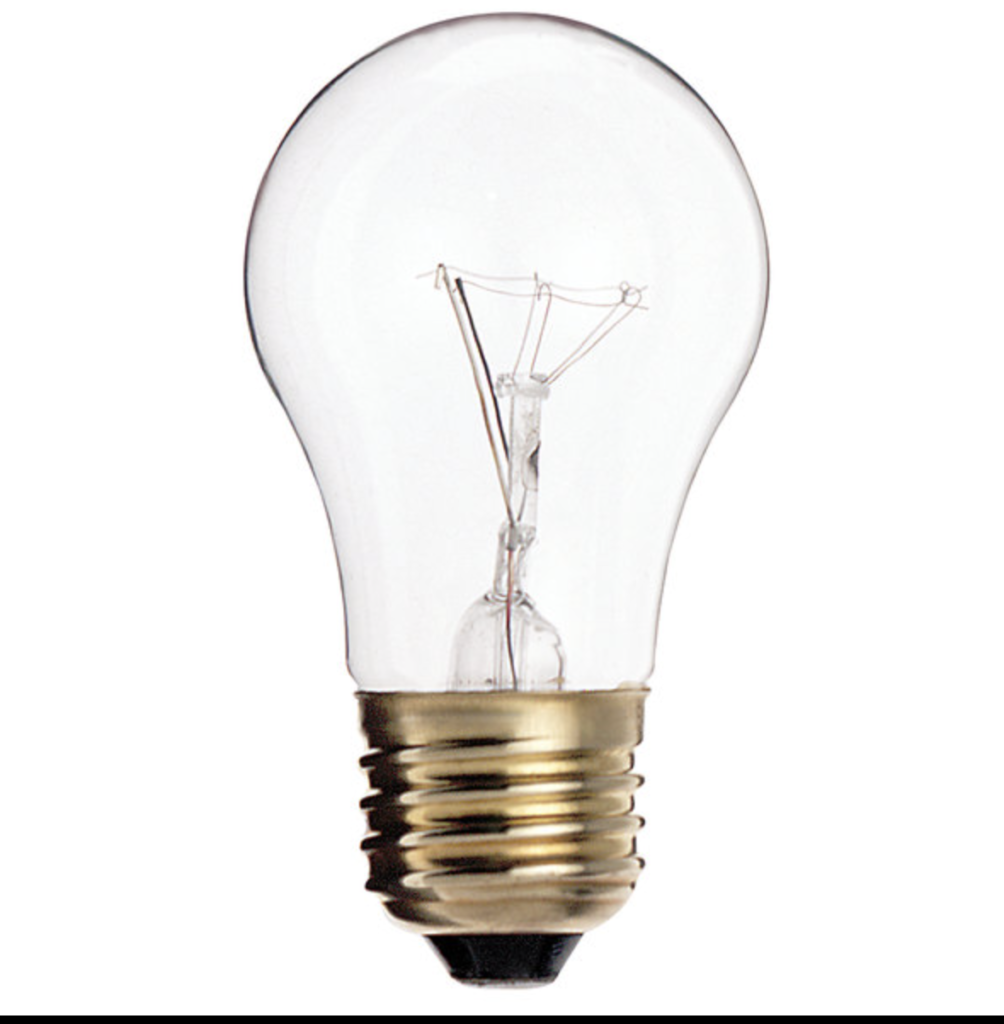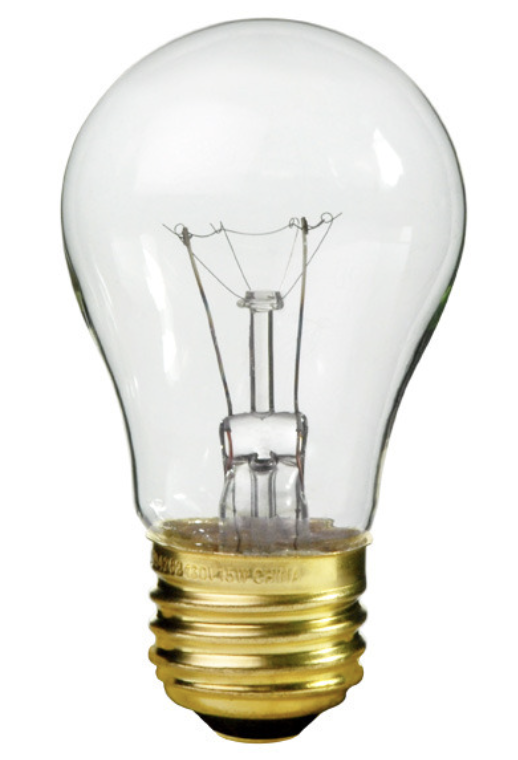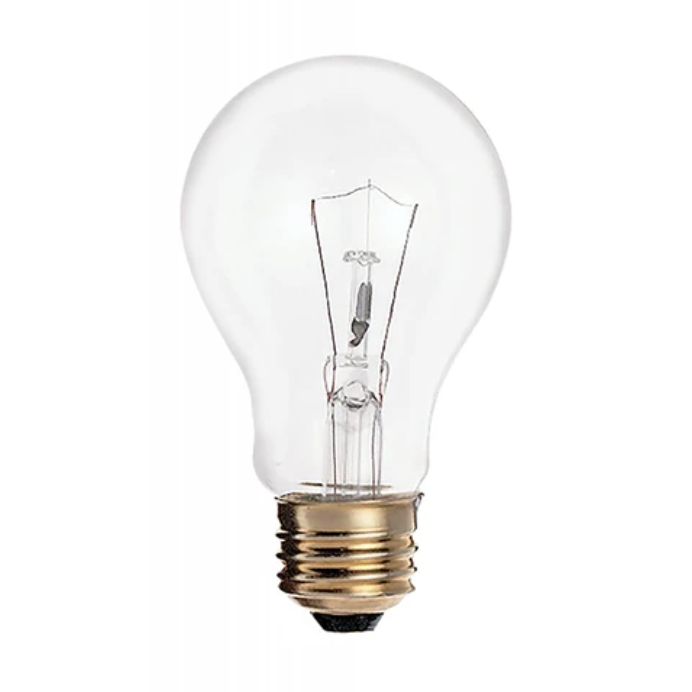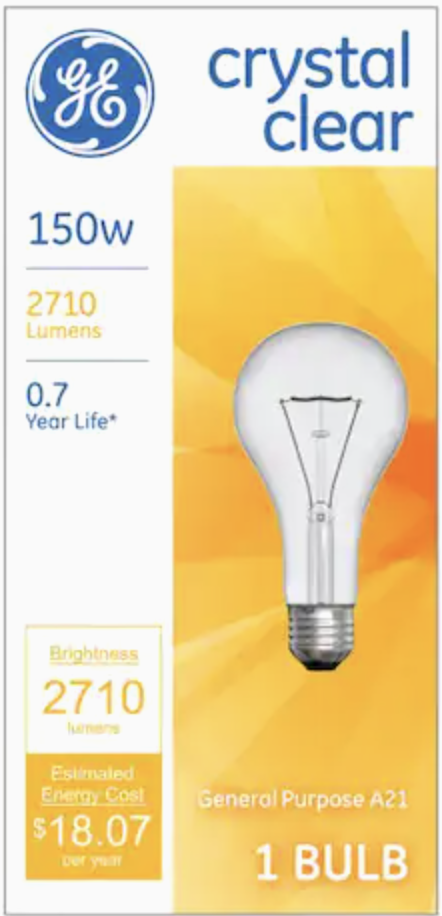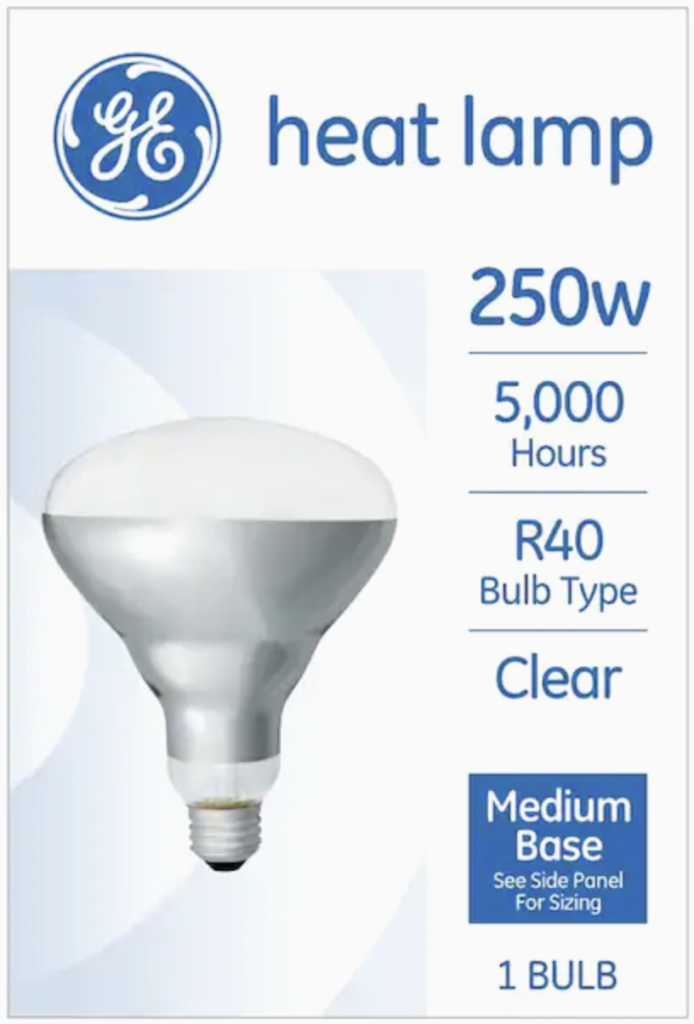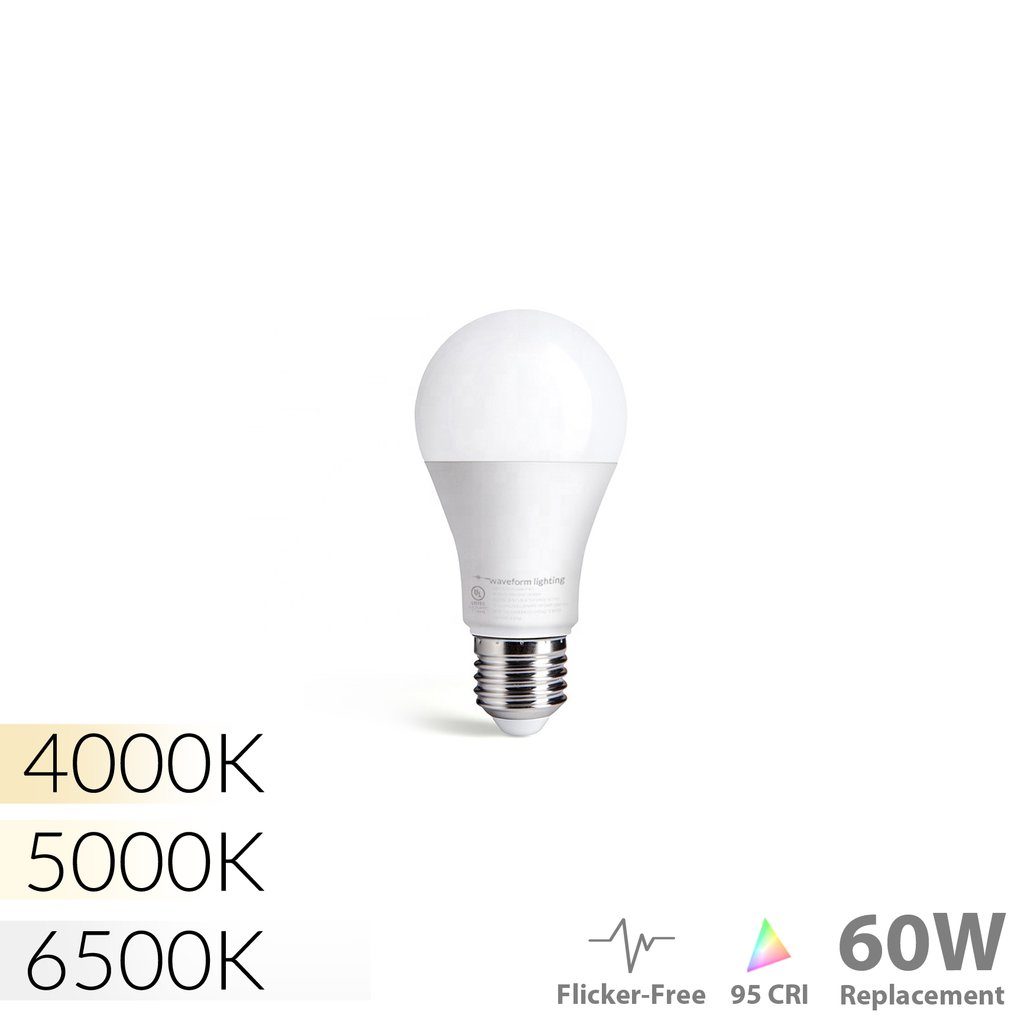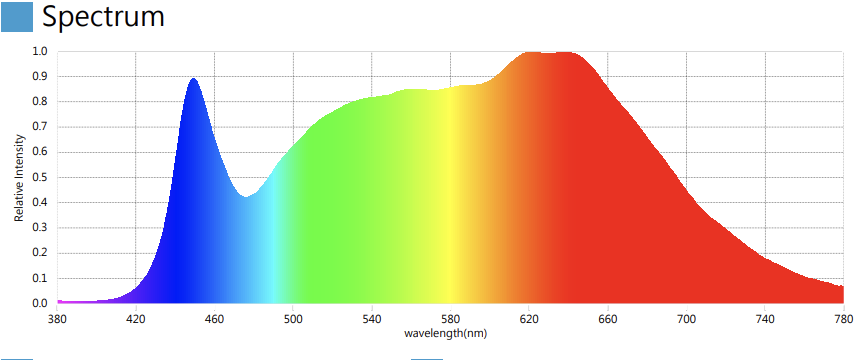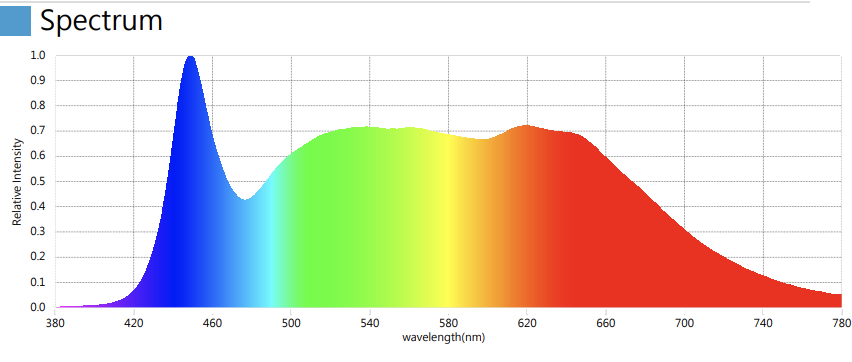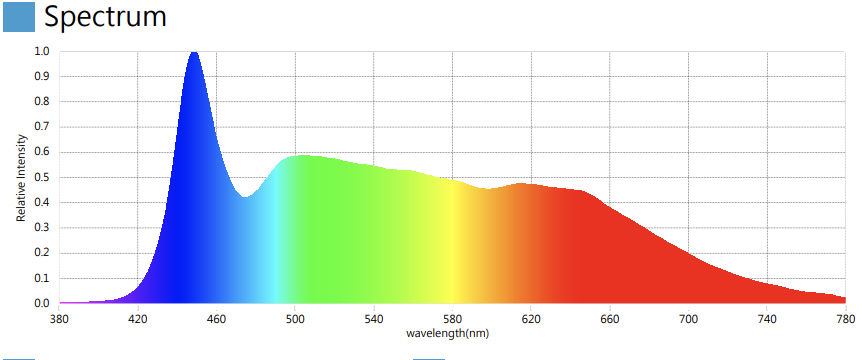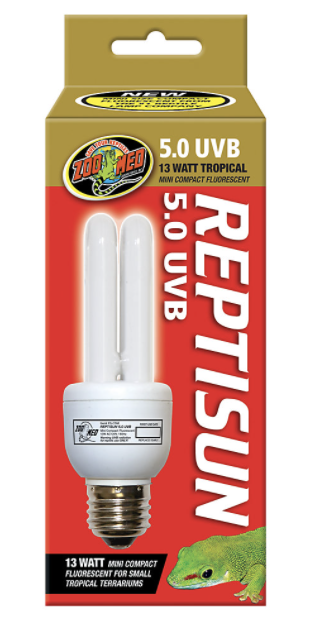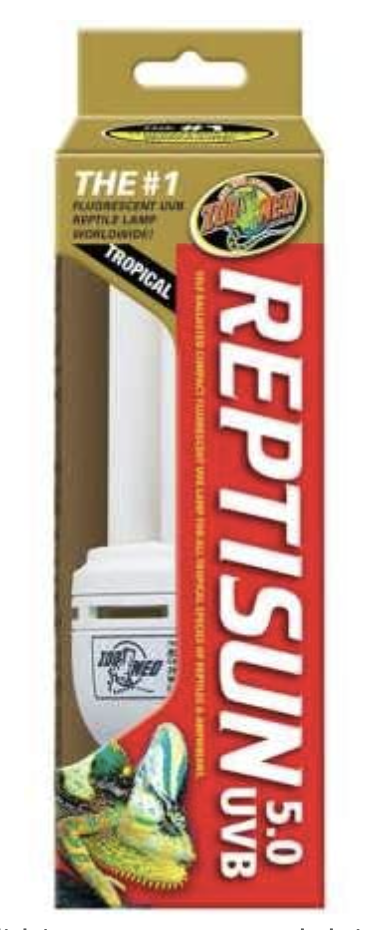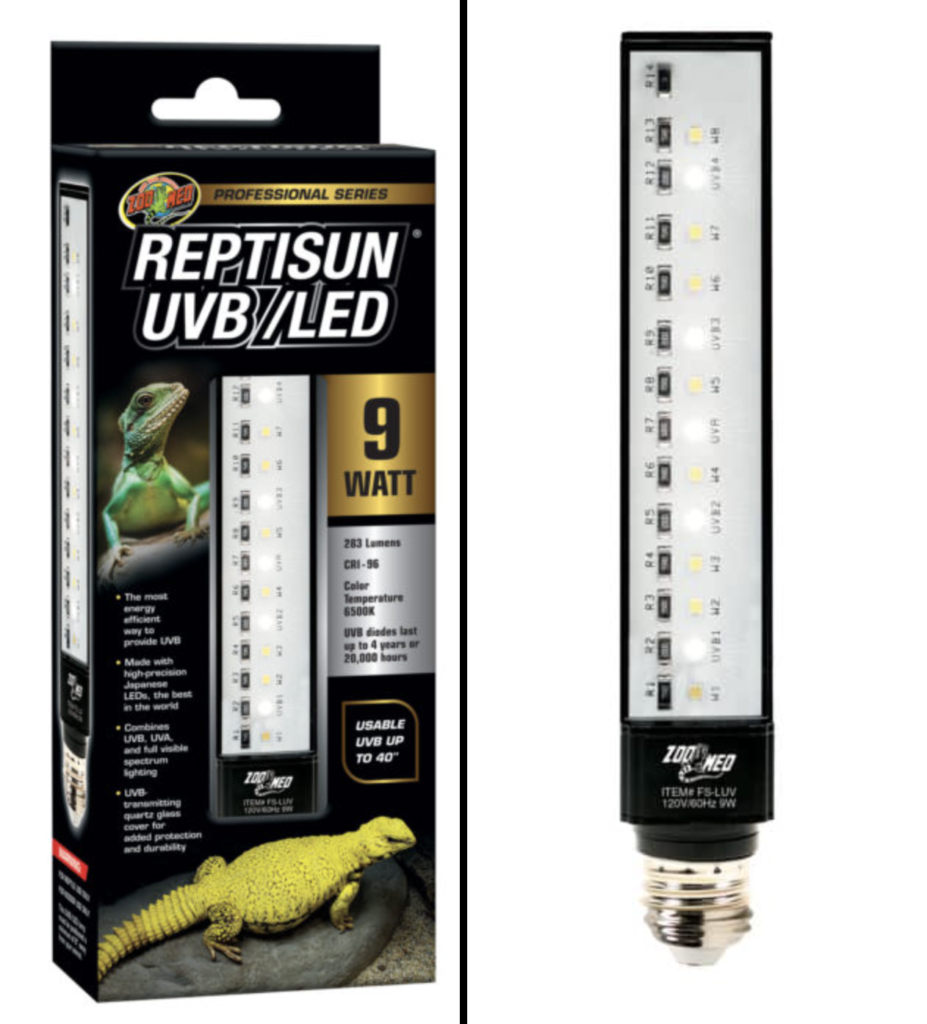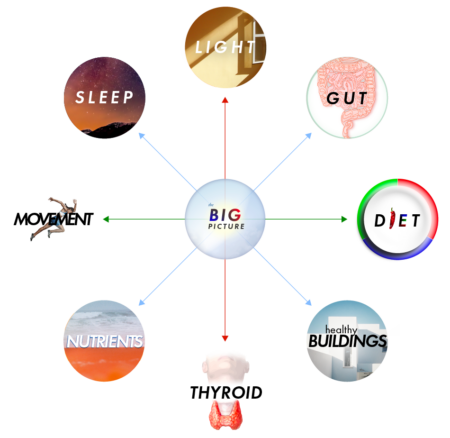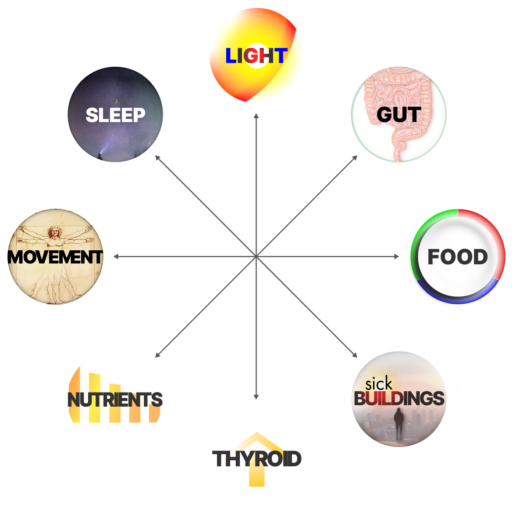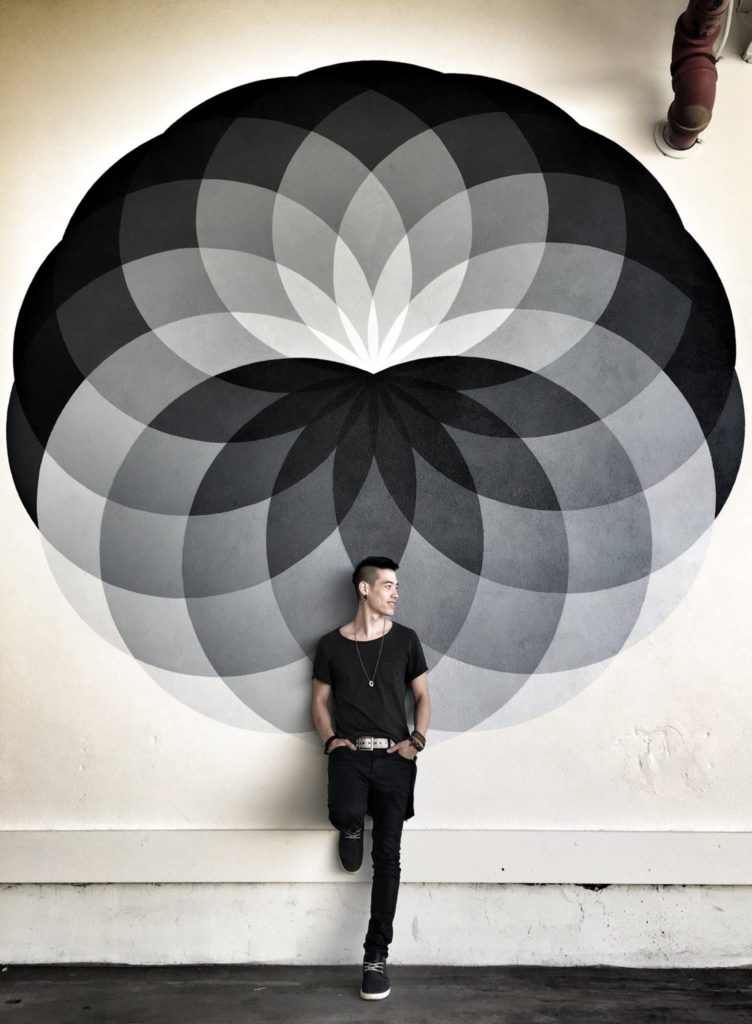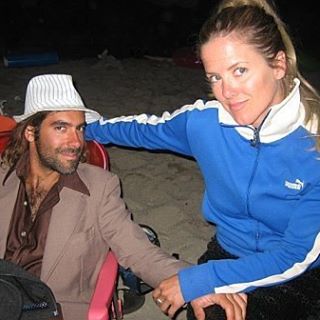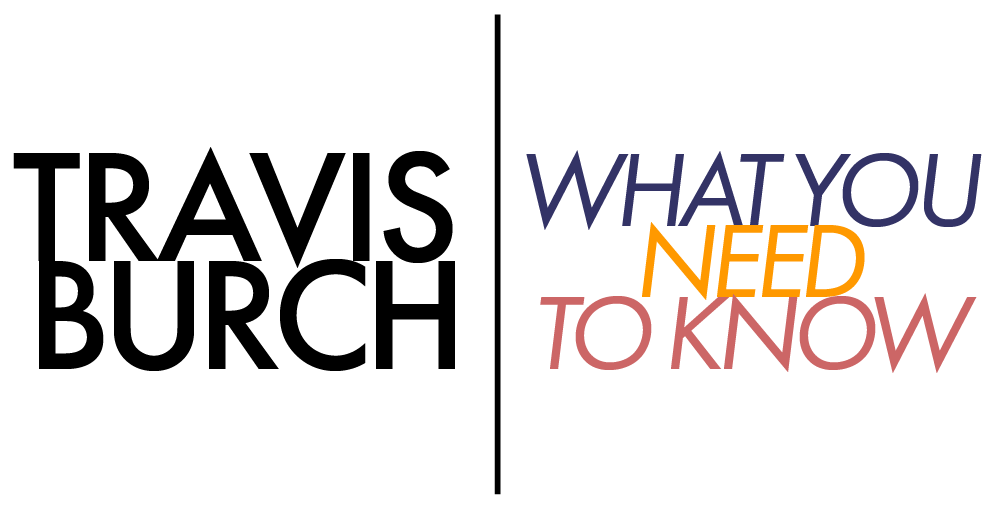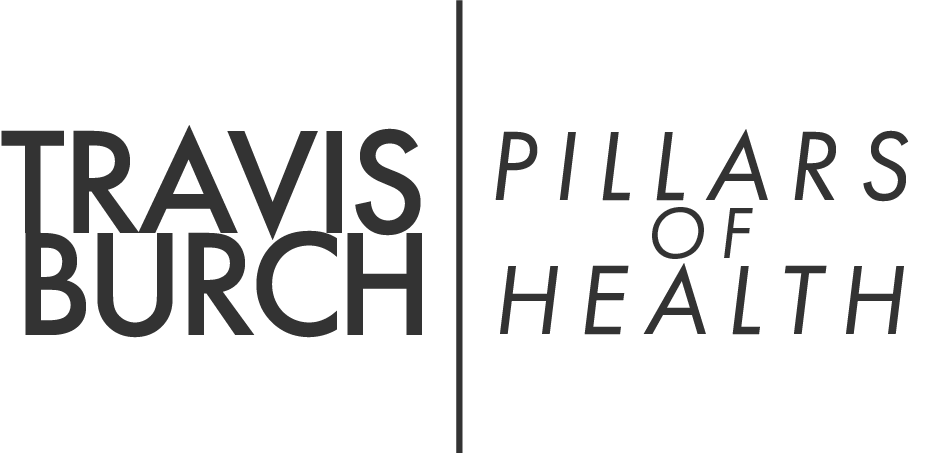In the long winter months — or even during summer days — our bodies need healthy, light.
Healthy lighting includes broad-spectrum frequencies of light, in smooth natural output curves.
Clearly, sunlight — as a “blackbody radiator” (it emits a continuous spectrum) — is the best source of natural spectrums of light.
Yet, we don’t want to mimic sunlight perfectly — that would include too much UV and be too intense. After all, sunlight provides roughly 1000 watts of light on our body, alone, often with enough UV to cause serious burns.
Instead, we need indoor lighting to be:

- full-spectrum
- safely balanced
- in reasonable doses
…so that it can encourage:
- alertness
- hormonal balance
- great digestion
- thyroid function
- circadian alignment
- digestive well-being
Let’s quickly explore the components of healthy indoor lighting.
First, blue and red wavelengths need to be balanced, in at least a 1:1 ratio, — if not 2-3x more red than blue.
Incandescents typically have much more red than blue, while fluorescent and LED bulbs are typically the opposite — LEDs have 2-3x the blue of red.
Incandescent bulbs are, therefore, despite poor energy efficiency, a nearly-optimal foundation for healthy indoor lighting. Yes, halogens are a type of incandescent and are thus nearly always a good alternate option, as well.
Second, sunlight produces healing infrared frequencies that are restorative for the human body. Incandescent bulbs produce massive amounts of invisible infrared light.
While this is wasteful from a lighting and efficiency perspective, these frequencies encourage health in the body. LEDs and fluorescents produce very little infrared. Therefore, incandescents are preferable for healthy indoor lighting.
Third, sunlight does not flicker — it is a smooth, continuous source of healing light.
On the other hand, LEDs and fluorescent bulbs flicker several hundred times per second — in part, to save electricity. Half the time during use, these bulbs are entirely or nearly off. LEDs flicker is virtually completely on/off — saving literally half the power required to run the bulb.

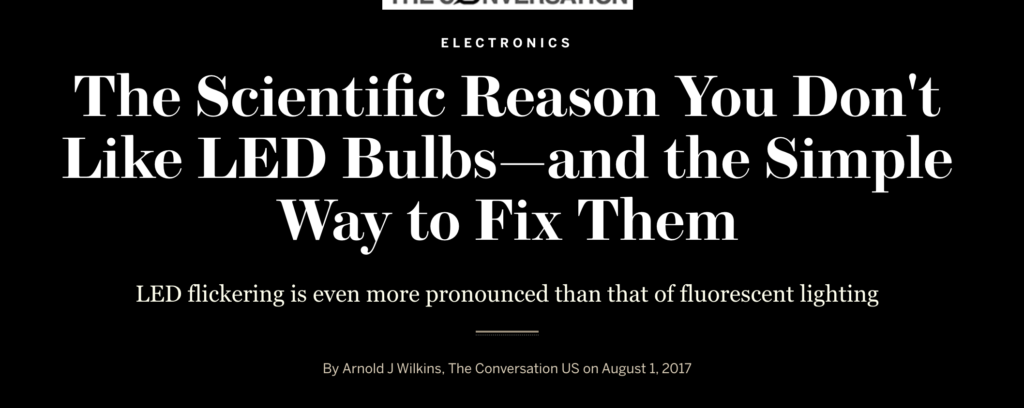
This flickering light has been shown to have detrimental effects in humans and other species.
https://www.ncbi.nlm.nih.gov/pmc/articles/PMC4038456/
By contrast, incandescent bulbs don’t flicker at all — they mimic sunlight in their smooth, continuous radiative energy. Again, this is more ‘wasteful’ from an energy efficiency perspective, but likely healthier for the humans living and working in a space.
Fourth, sunlight changes throughout the day, based on the amount of atmosphere it must traverse to reach the ground.
Warm reds begin each day, building with greens, and bright blues, and peaking with full UV power at midday.
Thus, using these four characteristics:
- red/blue balance
- infrared
- non-flickering
- change throughout the day
…we can successfully recreate sunlight and enjoy the benefits of healthy indoor lighting.
Let’s discuss just how easy it can be.
The best source of red and infrared light is clearly the traditional incandescent light bulb.
Sadly — at least for human health reasons — incandescents have been phased out around the world, prohibited from being sold as normal light bulbs. However, they are still available in many online retailers, and can often be sold when marketed as “specialty” bulbs.
Clear incandescents are usually best, with no filter to alter their spectral output.
Nearly any wattage can be appropriate — from 15 watts for night-time use, to 40 watts for Zoom call lighting (on the face), to 60 watts for daytime room lighting, to 150-300 watts for strong daytime room lighting or therapeutic dosages.
| Incandescent Bulb | Best for: |
|---|---|
| 15 watts | Night-time use |
| 40 watts | Zoom call lighting |
| 60 watts | General purpose; Daytime room light |
| 150+ watts | Strong daytime room light; Therapeutic light |
Sometimes, especially in winter, heat lamps can be very appropriate for either room lighting or therapeutic light.
At 125 or 250 watts, they are simply incandescent bulbs on steroids — overloaded with infrared and red, and very limited in the shorter blue spectrum. However, they are missing so much blue that they need supplemental blue frequencies to successfully recreate sunlight.
Bright, clear incandescent bulbs are appropriate from sun-up to sundown.
Lower-powered incandescent bulbs (40w and lower) are safe to use even until an hour or two before bedtime.
The One LED Bulb that can Almost Replace a Clear Incandescent
Consider their SUPERWARM™ 1700K Flicker-Free A19 10W LED Bulb and its spectral output:
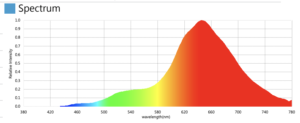
This bulb almost perfectly recreates clear incandescent light, with two differences:
- Full-spectrum, red-rich frequencies
- Zero flicker
The only downside is this bulb produces zero infrared. However, this may be acceptable in summer, when combined with another infrared-producing bulb, or at night.
In other words, the infrared produced by clear incandescents is extremely valuable to the human body, but the SUPERWARM bulb by Waveform is an incredible substitute.
This bulb’s light is attractive, appealing, and warm. Use wherever incandescents are appropriate. Especially appropriate for morning and evening use.
Just know that, theoretically, this bulb is missing infrared — which would be superior.
In reality, most incandescents alone struggle to produce enough blue to mimic sunlight — only the 150w bulbs produce any notable blue.
Even still, those stronger bulbs don’t produce nearly enough blue light to mimic sunlight.
- Enter a new company I discovered earlier in 2021 called Waveform Lighting.
Waveform Lighting specializes in LED bulbs that are flicker-free and full-spectrum.
Just like the SUPERWARM (mentioned above), Waveform also offers bulbs at virtually every color temperature: 1700K, 3000K, 4000K, 5000K — and it makes sense to use one of these in addition to the incandescent. Why? To better mimic sunlight.
Blue light is essential for many biological functions:
- informing the body when it’s daytime
- suppressing daytime melatonin,
- keeping us alert
- activating dopamine
- and much more
We are certainly exposed to too much isolated blue light in modern environments. But that doesn’t mean blue is unnecessary — we need it to function.
In fact, with a foundation of lots of red/infrared, the body can properly benefit from the right amount of blue.
Therefore, it’s wise to supplement a higher color temperature bulb — such as this non-flickering 4000K daytime LED — with our incandescent bulb.
Three options are available from Waveform Lighting — with varying amounts of blue/red:
I recommend the 4000K bulb for most situations, but the 5000K and 6500K provide lots of blue — perfect for larger spaces or with higher wattages of incandescent light.
These blue-rich LED bulbs are appropriate to use beginning later in the morning (9 am or so) until about 6 pm.
So far, we’ve added two non-flickering, full spectrum light bulbs:
- Incandescents — delivering heaps of red/infrared
- Waveform Lighting LEDs — delivering full-spectrum light, including rich blues.
Sunlight also includes UV — should you consider adding this, too? Let’s find out.
UV plays an important role in circadian, hormonal, digestive, immune, and cognitive health.
Many are beginning to champion the critical effects UV has on the body, via Vitamin D3 production and other avenues.
However, caution is advised when it comes to ultraviolet frequencies — less is more. There is no need to ever sunburn.
There are two methods to reap the benefits of indoor UV light:
- As a background frequency in work spaces — perhaps for several hours around midday (and mostly for circadian benefiets via the eyes) — by placing a small UV bulb 10+ feet away, and shining away from the body
- A therapeutic dose on the full body, at 2 feet away, in only a few minutes per day.
When UV light is present in a workspace, folks often notice better mood, more alertness, and more energy.
Whether aiming for background lighting or a full-body therapeutic dose, it’s best to combine the UV bulb with your red/infrared bulb. The longer frequencies (red/infrared) nourish and help protect skin from negative effects of UV — especially before UV exposure.
The tanning bed could be a very natural and simple solution for getting weekly UV exposure — and this works extremely well for many people during during winter months. But tanning salons have become hard to find, and using them safely is complicated. In general, shoot for:
- “medium-pressure” beds,
- once per week for only 5-6 minutes (for most people).
If using a tanning bed, be sure to get red/infrared therapy before or after the tanning session.
In-Home Therapeutic UV Options
There are two basic options for in-home UV:
Surprisingly, these two are — essentially — the exact same thing, except for one difference:
- Reptile bulbs provides 13-26 watts
- Sperti Lamp provides 300 watts
Let’s analyze the pros/cons of these two options.
(1) Sperti Fiji
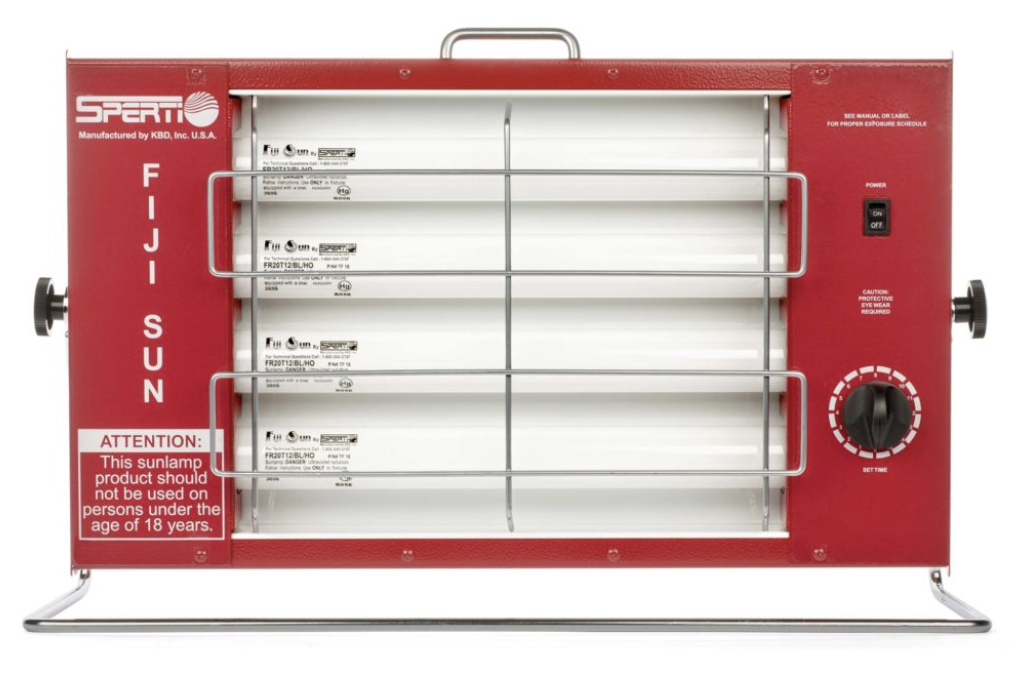
(click to open)
(2) Reptile Bulbs
Which is more appropriate for you?
Most people who buy the Sperti eventually realize two things:
- How difficult it can be to expose the entire body to such a small lamp
- How powerful it is — it only takes a few minutes to 1) burn, or 2) raise Vit D levels too high
These are real risks with the Sperti. It’s a quality device, for sure, but far too many people buy them, only to have to stop using them.
The biggest problem with the Sperti is its low UVA output. UVA output controls Vitamin D production in the body, too — and too little can cause Vit D levels to rise too high.
Therefore I only recommend a Sperti (even the Fiji device) if you fully understand these risks, how powerful its UVB output is, and are ready to supplement additional UVA.
I’m a bigger fan of the low-key, unassuming reptile bulbs.
They produce very similar light, though these particular ZooMed bulbs (above) produce a better UVA-UVB ratio (6:1). Compared to the Sperti, these bulbs are:
- gentler
- less likely to cause problems
- able to raise Vitamin D levels much more slowly
- less likely to burn you
- smaller, less in the way
You can dip your toes with the 13 watt bulb, or get the stronger one with 26 watts — it’s stronger than you’d expect. Which demonstrates just how (too) powerful the 300 watt Sperti is.
Consider spending 3-5 minutes per day in front of a reptile bulb, mid-day, preferably after a shower or other exposure to heat and red light. Protect your eyes from UV: don’t look at the bulb while on, and wear eye protection. Alternating days is a great idea; observe how you feel on days on versus days off.
As we’ve mentioned, most bulbs marketed for UV light are primarily designed to deliver UVB — and don’t provide sufficient UVA to mimic sunlight.
This can lead to multiple problems in your body — including Vitamin D regulation — especially with the immensely powerful Sperti lamps (and low-pressure tanning beds).
Let’s first understand what the sun’s UV spectrum looks like. How much UVA does it contain — relative to UVB?
What is the sun’s natural ratio of UVA to UVB?
- In space — (20:1 ratio)
- Before sunlight travels through the atmosphere — solar radiation contains 20X more UVA (than UVB).
- On earth — (500+:1 ratio)
- UVB is filtered out by the atmosphere.
- Typical sunlight, on earth, has 500-100,000X more UVA than UVB — for much of the year, and most of the day.
- This UVA-rich light what humans are adapted to.
- We need much more UVA than we do UVB.
- An optimal UVA/UVB ratio keeps Vitamin D levels from rising too high.
- Bulbs — (much lower ratios)
- Sperti (classic) is 1:1
- Sperti (Fiji) is 3:1
- ZooMed bulbs I recommend (above) are 6:1.
So do we need more UVA than most “UV bulbs” provide? We probably do.
It is possible to get UVA during winter! However, this would require exposing lots of skin to sunlight — outside — during potentially cold weather. This can be an option, a very healthy option, for many.
For others, we’ll need a bulb that creates a decent stream of UVA light.
Here is the best option I’ve found so far:
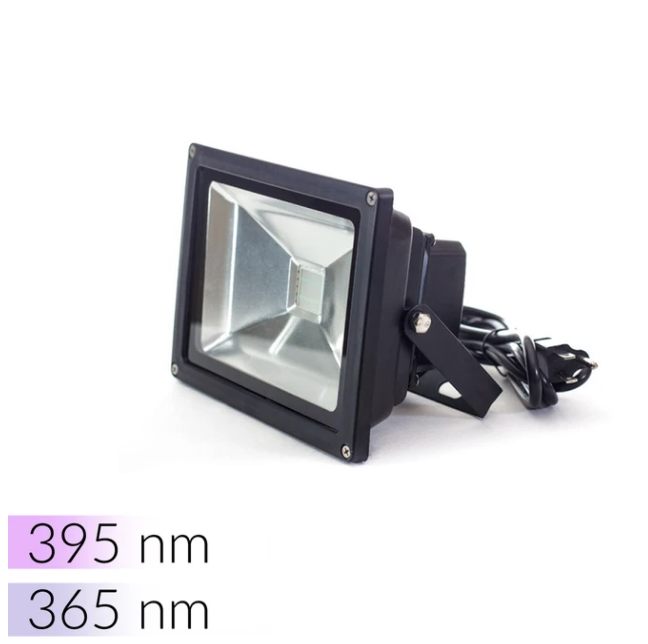
(click to open)
If you get the Waveform realUV black light, you’ll need to stand a minimum of 2 feet away during light therapy, if not a bit further. It’s a strong light. It’s also strong enough to be across the room and immerse the room in quality UVA light — which can be good for health.
You’ve got the components: infrared, red, blue, UV. Now let’s put them together in a way that helps you re-create sunlight.
Let’s begin with a simple light setup at your desk or workspace.
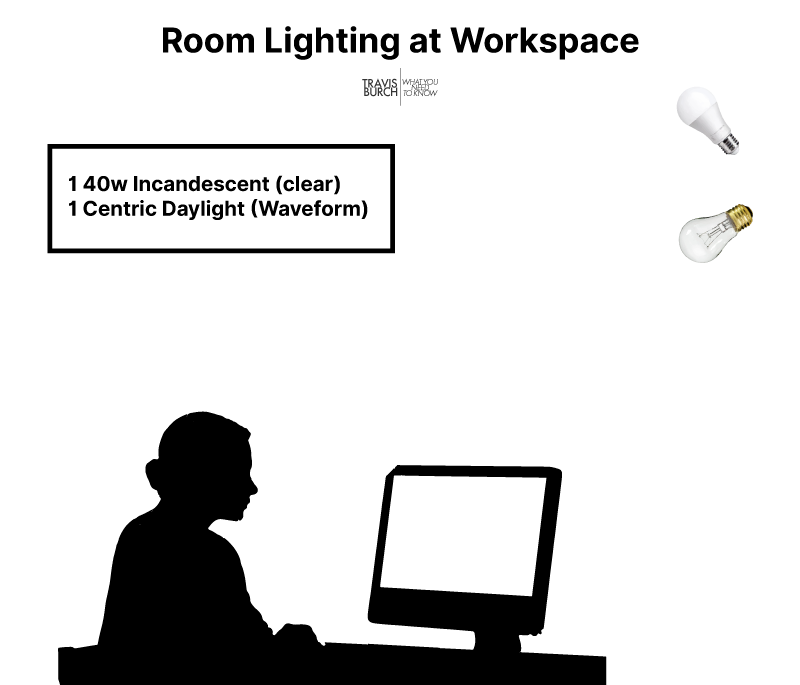
First thing in the morning, and when working after dinner, I’ll leave the Daylight bulb off — and use the 40 watt incandescent by itself.
On cold days, you might especially want more heat, infrared, and red light. Turn on a heat lamp, 3-5 feet behind you, to mimic summer sunshine while you work:
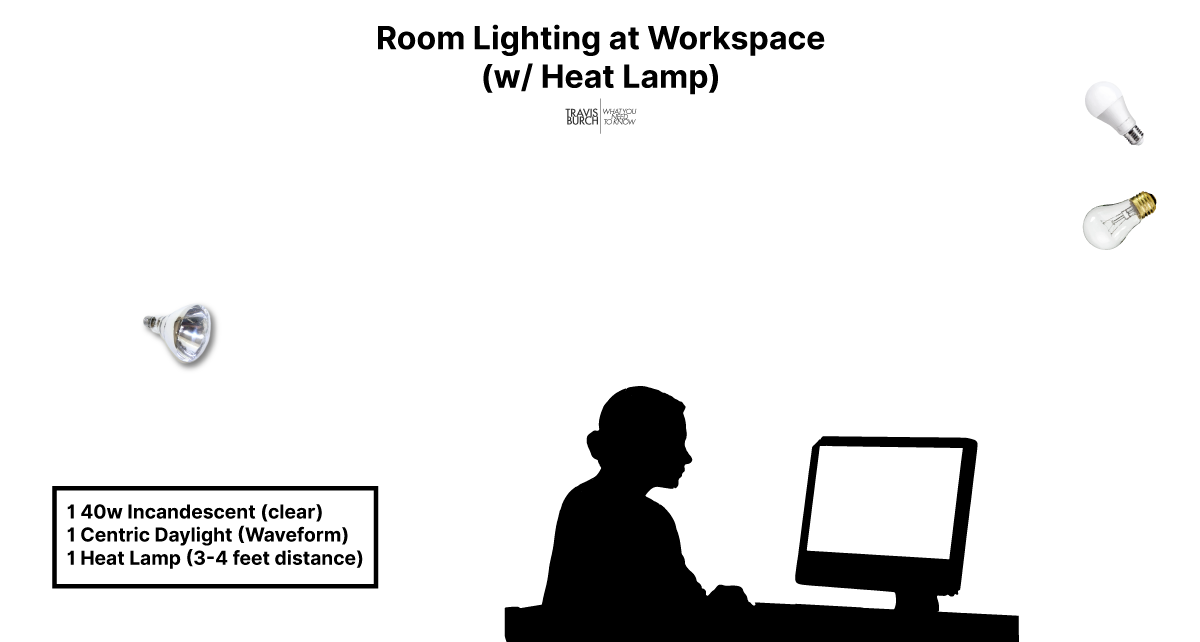
With the heat lamp, the Daylight bulb (and 40 watt incandescent in front of you), the only frequencies lacking — to recreate sunlight — are in the UV range.
Add in a reptile bulb to introduce some UV into the room.
Being far behind you (and if you’re clothed), this UV will not provide therapeutic light, but instead signal “daytime” to your brain and help keep you alert.

Finally, if you’d like a more therapeutic, intense dose of these frequencies, utilize two or more heat lamps (250 watts each), a reptile bulb, and a black light.
Keep in mind that real sunlight provides about 1000 watts on the typical human body. This setup provides just over half of that.
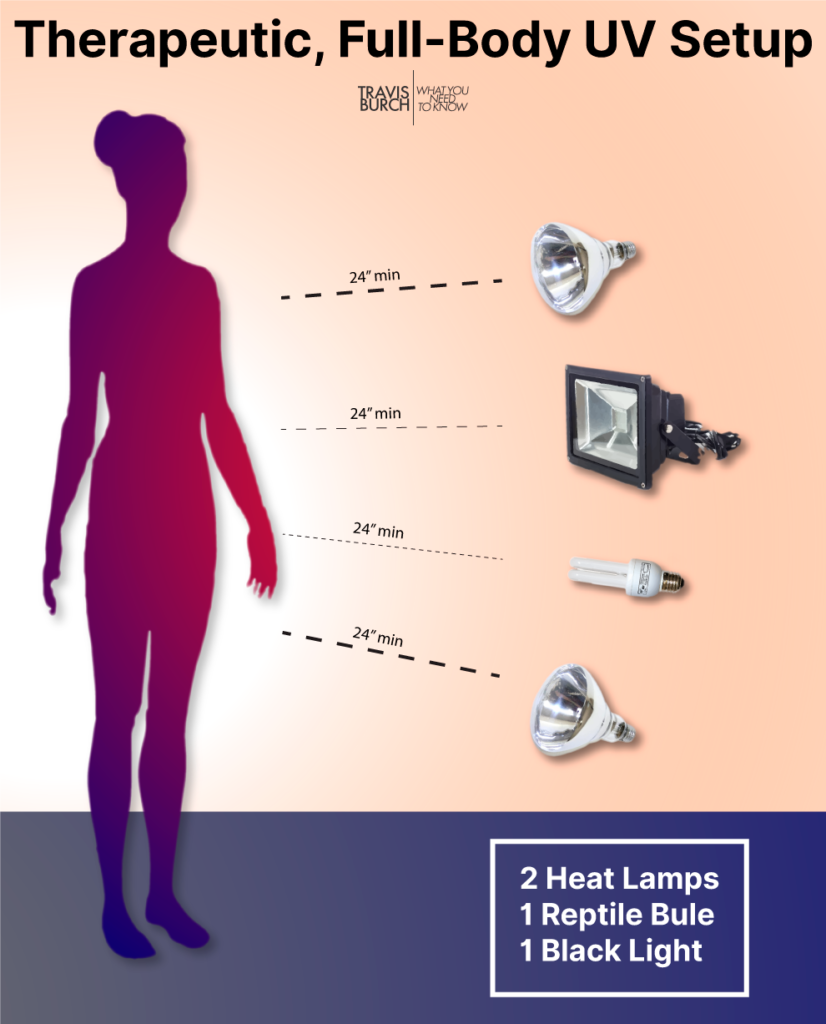
Where do red light LED products fit into this?
- Generally red light LEDs are best used for therapeutic purposes: Intense, full-body light for 10-30 minutes at a time.
- Red LEDs do not mimic sunlight, and are inferior to heat lamps.
My Experience
When I was living in sick buildings — and hadn’t realized their detrimental effect yet — I fell in love with light therapy. Recreating sunlight helped me feel wonderful when nothing else could.
Over the years, I worked up to ten 150 watt clear incandescent bulbs and used them for a long time. Impressive was the ability to warm, induce sweat, improve digestion, immunity, and sleep, and energize the mind — even in a sick building.
I’d do a 20 minute session before work, and then a longer session when I got home in the evening. On breaks, I’d go outside for fresh air and sunlight. I wore blue-light reducing glasses inside, under the fluorescent light.
Healthy, restorative light became a big part of my life — and my recovery.
Related Articles

Why ‘Nobody’ Believes the Mold Sufferer
If there were a battle hymn of the mold sufferer, it would be titled: “Why Does Nobody Believe Me?”

An Exercise for Dealing With Loved Ones We Disagree With
An 11-question inventory for furthering relationships.

What I Do (New: 7-15-2023)
Here’s what I’m currently doing to improve my health.

‘Sensitization’ = Environmental Illness?
An introduction to environmental sensitivities.
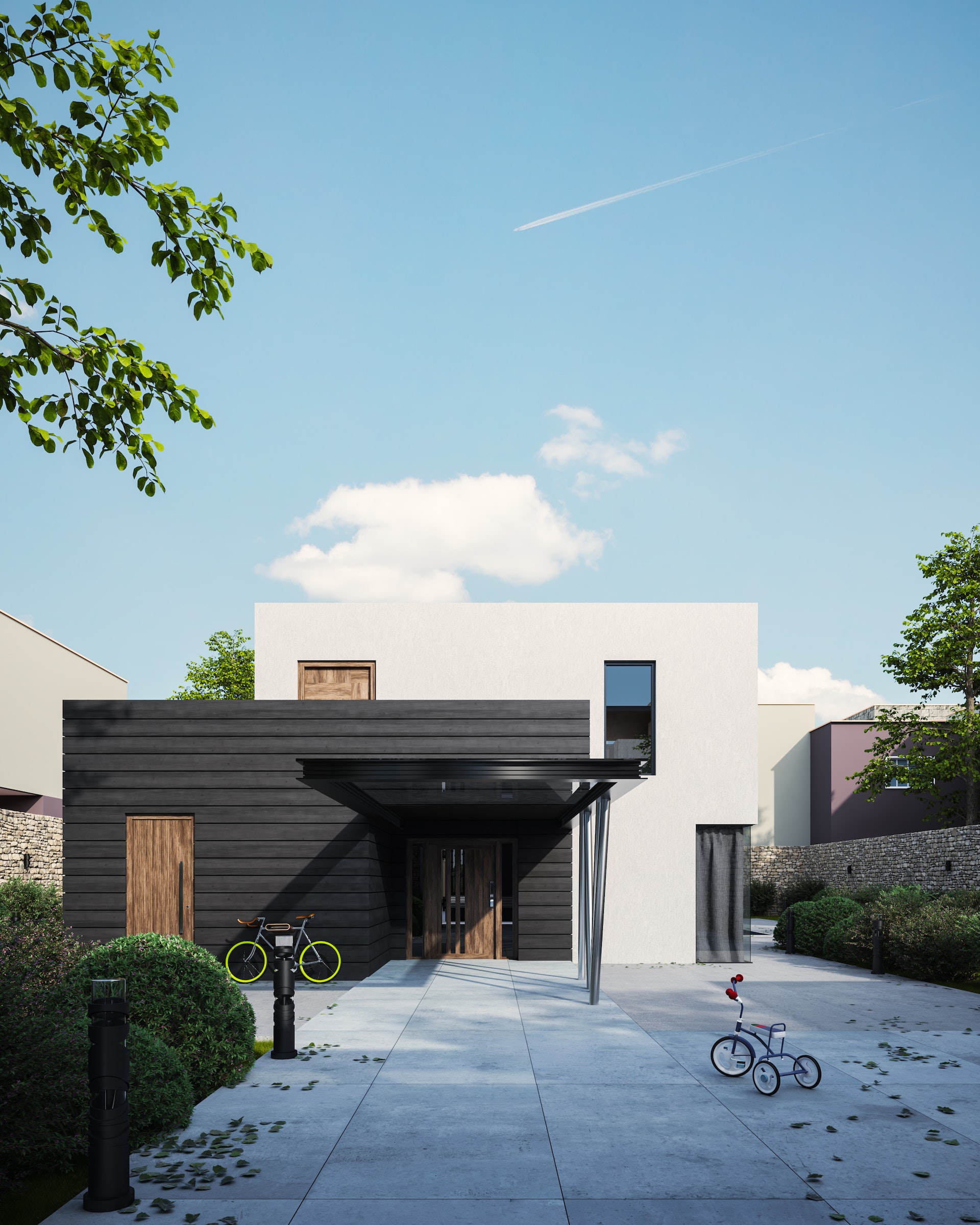
5 Elements of Healthy Buildings
Let’s run through five big elements of healthy buildings.

Nutrient Balancing for Insomnia
Certain nutrients are much more important for sleep than others.

